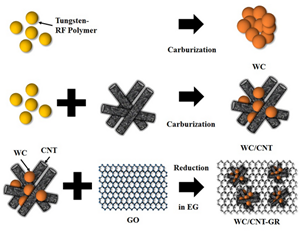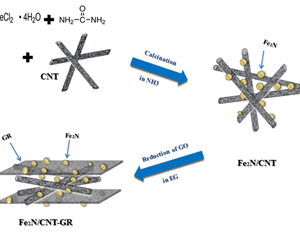Go to the top
Development of Membrane and Electrodes for Fuel Cells
Fuel Cells are energy conversion devices which convert chemical energy of fuel into electric energy directly. They are more efficient compared to combustion engines. Also, undesirable products such as NOx and SOx are virtually zero.
LTFCs (Low Temperature Fuel Cell), PEMFC and DMFC, have high energy density so they are suitable for portable device and transportation. However, limited resources and high cost of Pt in electrodes hinder the widespread commercialization of fuel cells. Further, the high cost of membrane and low oxidation rate of methanol remained as technical drawbacks.
We focus on the development of composite membrane to substitute for Nafion membrane using inorganic filler and carbon. In electrodes case, we investigate tungsten carbide for anode catalysts, nitrogen treated carbon and nitride materials for cathode catalysts to make low-Pt or non-Pt electro-catalysts.
- Synthesis of noble-metal-thrifty electro-catalysts for electrochemical oxidation of ethanol and hydrogen.
- Development of Inorganic Fillers for Polymer Composite Membranes for DMFC.
- Research for cathodic catalysts preserved the high corrosion resistance on carbon materials.
- Direct methylformate fuel cell.
연료전지용 전해질막 및 전극 개발
인류가 당면한 에너지 및 환경 문제를 극복하기 위해, 다양한 차세대 에너지 개발이 전세계적으로 주목 받고 있다. 수소에너지는 기존의 화력 발전과 달리 연소과정이 없기 때문에 효율이 높고 친환경적이며, 풍부한 자원이라는 장점이 있어, 다양한 연구활동이 이루어져 왔다. 특히 연료전지 산업은 최근에 자동차, 베터리 등 실생활에 이용될 수 있는 형태로 적용되기 시작하며 두각을 나타내고 있다.
여러 형태의 연료전지 중에서 저온형 연료전지에 해당하는 PEMFC (Proton Exchange Membrane Fuel Cell)와 DMFC (Direct Methanol Fuel Cell)는 높은 에너지 밀도를 가지며, 낮은 온도에서 화하에너지를 전기에너지로 바꾸어 줄 수 있기 때문에 이동용 장치 및 운송수단 등에 적합하다. 그러나 상용되는 Platinum 촉매는 높은 가격, 낮은 매장량, 고가의 Nafion Membrane (Dupont사) 사용, 메탄올의 느린 산화속도, 그리고 연료의 crossover 등과 같은 기술적 장벽들이 남아 상용화에 어려움을 주고 있다.
본 연구실에서는 이러한 한계를 뛰어넘고자, 전해질막으로 쓰이고 있는 고가의 Nafion Membrane을 대체하기 위해 inorganic filler 및 carbon을 이용한 composite membrane을 개발하는 연구를 수행하고 있다. 전극의 경우 Platinum의 비용 문제를 극복하고자 Low-Loaded Pt catalysts, 더 나아가서는 Pt-free catalysts 전극물질 개발에 힘쓰고 있다. Anode에는 Tungsten Carbide, cathode에서는 Nitrogen doped carbon nanomaterials 및 Nitride 물질 등에 기반한 연구를 지속하고 있다.

